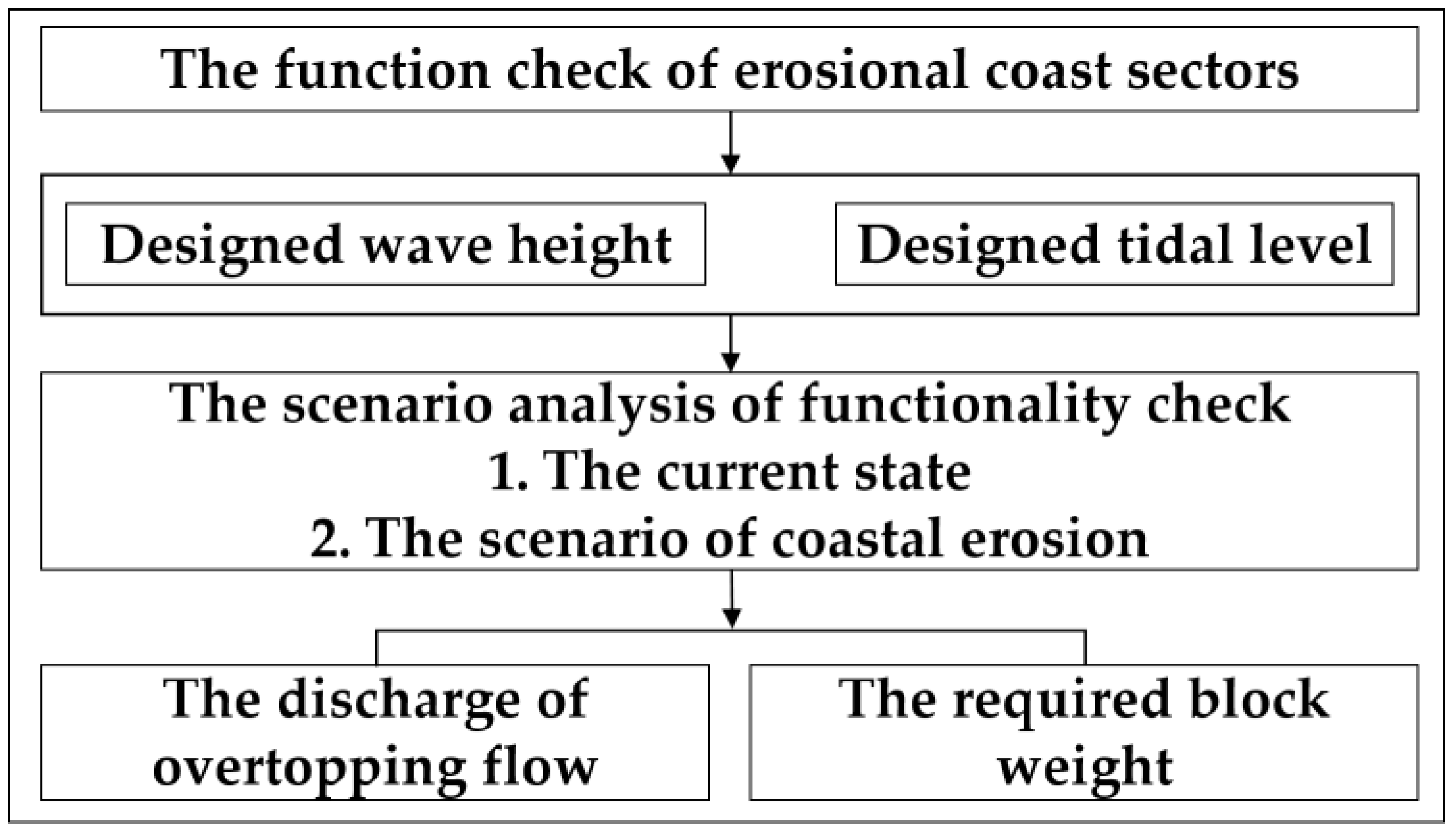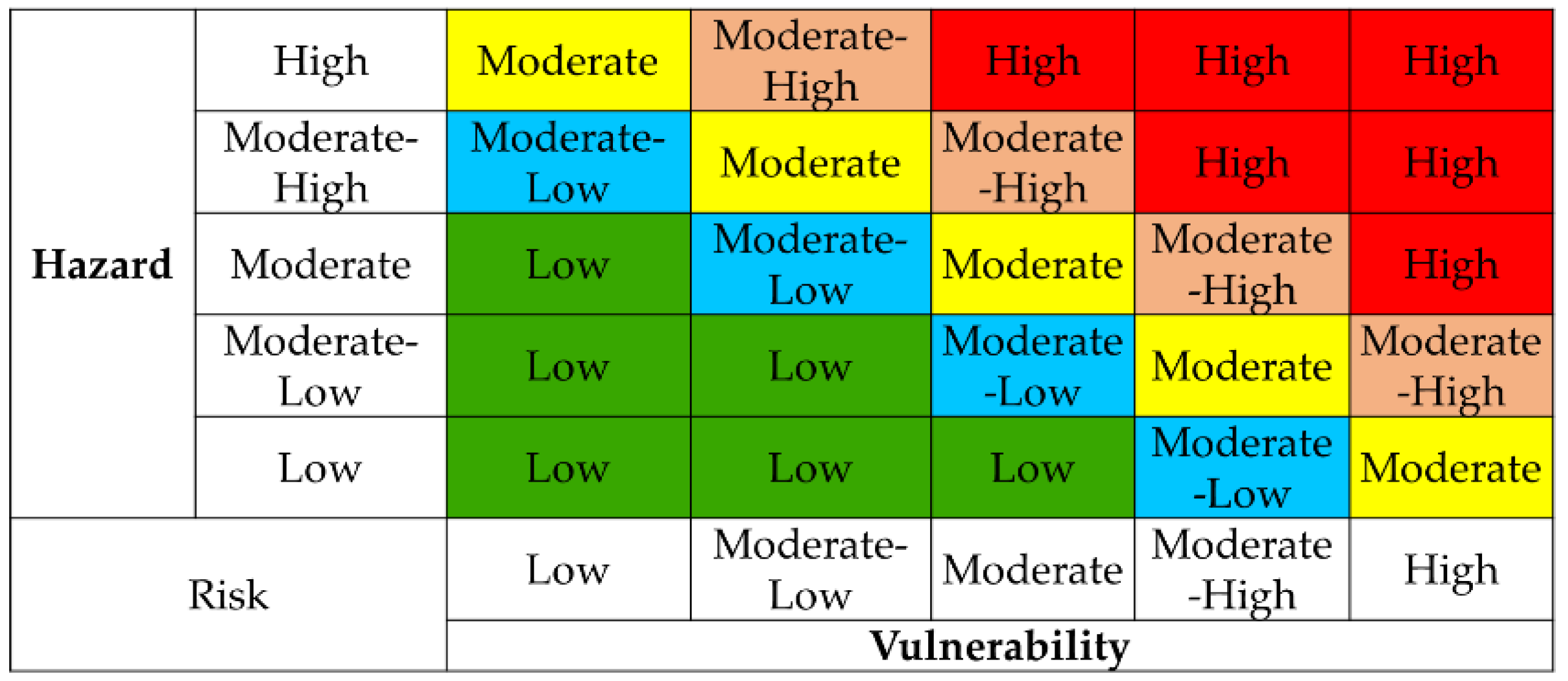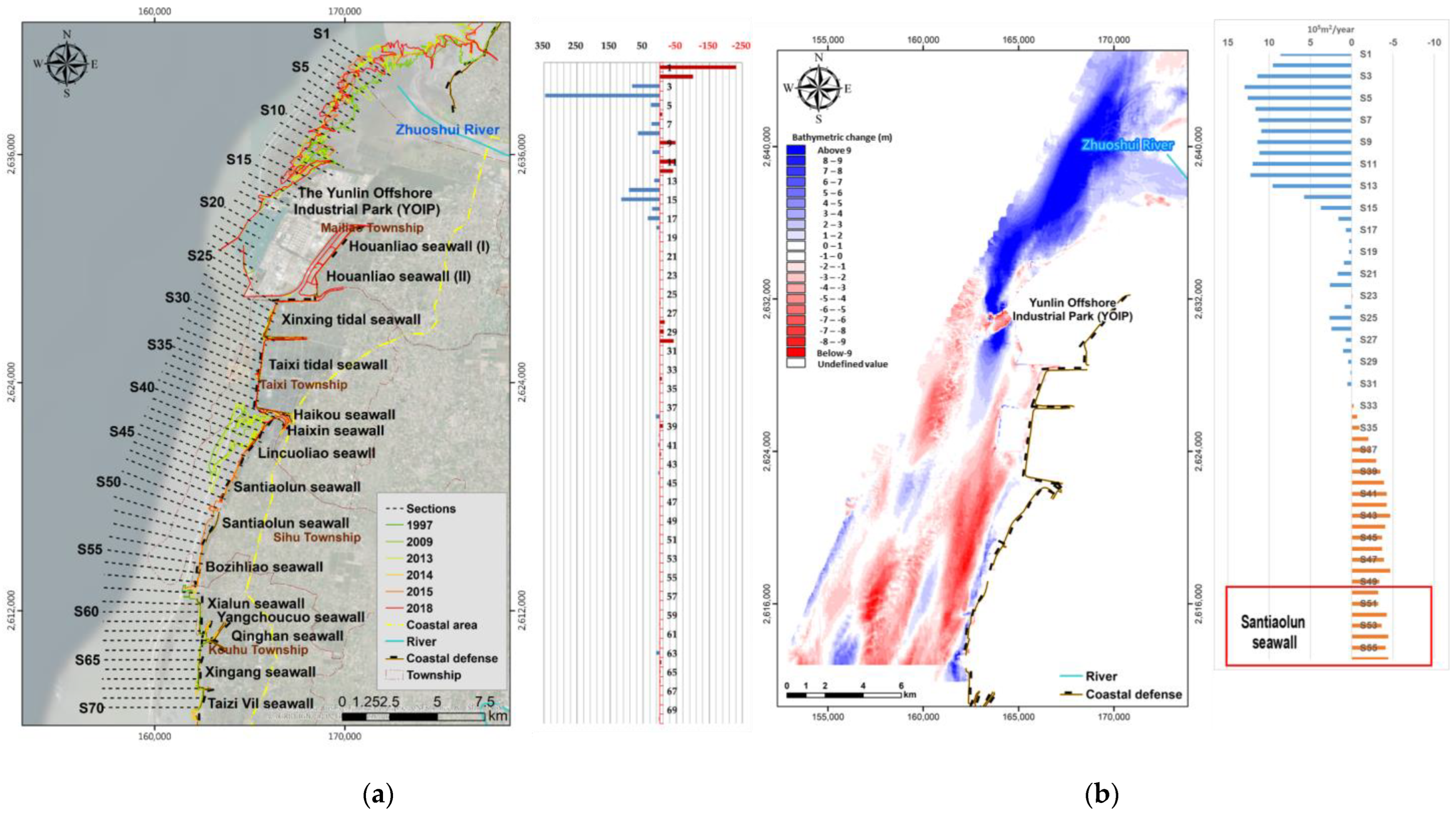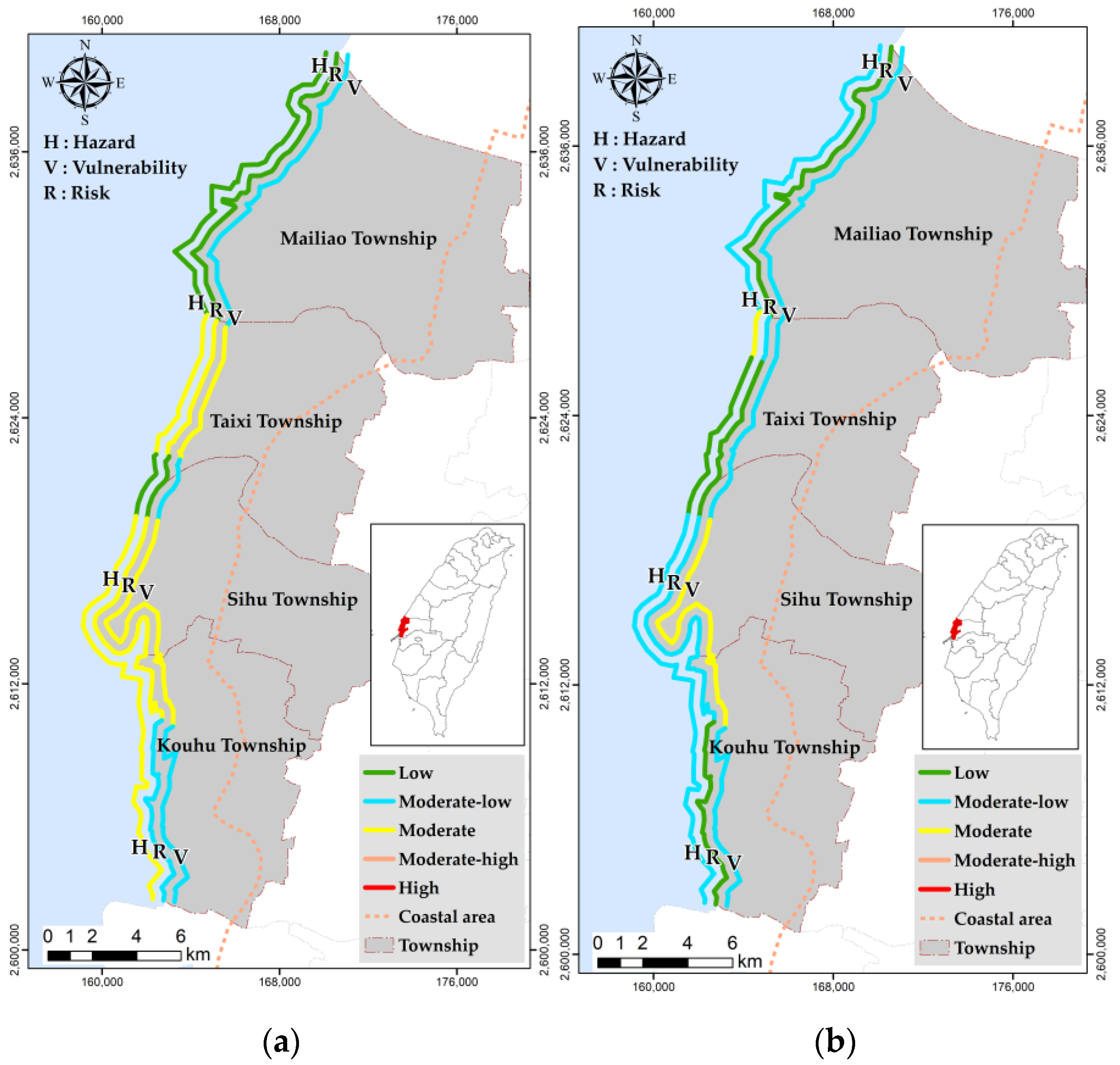Forecasts of the Compound Coastal Erosion Risks Based on Time-Variant Assessment: A Case Study on Yunlin Coast, Taiwan
Abstract
:1. Introduction
1.1. The Background of the Coastal Management in Taiwan
1.2. Risk Assessment of Coastal Area
1.3. Adaptive Strategy
2. Materials and Methods
2.1. Study Area
2.2. The Assessments of Coastal Erosion and the Mechanism of Erosion-Induced Hazard
2.3. Scenario Analysis of the Coastal Inundation Induced by Erosion-Induced Malfunction of Defense
2.4. The Coastal Erosion Risk Assessment
3. Results
3.1. The Assessment of Erosion Potential and the Functionality Assessment of Coastal Defense
3.2. Scenario Analysis of the Coastal Inundation Induced by Erosion-Induced Malfunction of Defense
3.3. The Coastal Erosion Risk Assessment
3.4. The Integrated Compound Coastal Erosion Risk
3.5. The Adaptive Strategy of Erosion-Induced Risk
4. Discussion
5. Conclusions
Author Contributions
Funding
Institutional Review Board Statement
Informed Consent Statement
Data Availability Statement
Conflicts of Interest
References
- Łabuz, T.A. Environmental Impacts—Coastal Erosion and Coastline Changes. In Second Assessment of Climate Change for the Baltic Sea Basin; Springer: Cham, Switzerland, 2015; pp. 381–396. [Google Scholar]
- United Nations Conference on Environment and Development. Agenda 21, Rio Declaration, Forest Principles; United Nations: New York, NY, USA, 1992. [Google Scholar]
- Ministry of the Interior. The Coastal Management Act; Ministry of the Interior: Taipei, Taiwan, 2015. [Google Scholar]
- Ministry of the Interior. The Integrated Coastal Zone Management Plan; Ministry of the Interior: Taipei, Taiwan, 2017. [Google Scholar]
- Ministry of the Interior. The Integrated Coastal Zone Management Plan—The First Overall Review; Ministry of the Interior: Taipei, Taiwan, 2021. [Google Scholar]
- Temmerman, S.; Meire, P.; Bouma, T.; Herman, P.; Ysebaert, N.T.; de Vriend, H. Ecosystem-based coastal defence in the face of global change. Nature 2013, 504, 79–83. [Google Scholar] [CrossRef] [PubMed]
- Mehrabani, B.M.; Chen, H.-P. Performance predictions of coastal defense using stochastic deteroration modelling. In Proceedings of the 1st International Conference on Uncertainty Quantification in Computational Sciences and Engineering, Rhodes Island, Greece, 15–17 June 2017; pp. 130–139. [Google Scholar]
- IPCC. Climate Change 2014: Impacts, Adaptation, and Vulnerability. Part B: Regional Aspects. In Contribution of Working Group II to the Fifth Assessment Report of the Intergovernmental Panel on Climate Change; Cambridge University Press: Cambridge, UK; New York, NY, USA, 2014; p. 688. [Google Scholar]
- CPSL. CPSL Third Report. The role of spatial planning and sediment in coastal risk management. In Wadden Sea Ecosystem No. 28. Common Wadden Sea Secretariat, Trilateral Working Group on Coastal Protection and Sea Level Rise (CPSL); CPSL: Wilhelmshaven, Germany, 2010. [Google Scholar]
- Thieler, E.R.; Hammar-Klose, E.S. National Assessment of Coastal Vulnerability to Sea-Level Rise: Preliminary Results for the U.S. Atlantic Coast. In U.S. Geological Survey Open-File Report; U.S. Geological Survey: Reston, VA, USA, 1990; pp. 99–593. [Google Scholar]
- Pendleton, E.; Thieler, E.; Williams, S.J.; Beavers, R. Coastal Vulnerability Assessment of Padre Island National Seashore (PAIS) to Sea-Level Rise. In U.S. Geological Survey Open-File Report; U.S. Geological Survey: Reston, VA, USA, 2004. [Google Scholar]
- Irham, M.; Rusydi, I.; Haridhi, H.A.; Setiawan, I.; Ilhamsyah, Y.; Deli, A.; Rusdi, M.; Siregar, A.M. Coastal Vulnerability of theWest Coast of Aceh Besar: A Coastal Morphology Assessment. J. Mar. Sci. Eng. 2021, 9, 815. [Google Scholar] [CrossRef]
- Boruff Bryan, J.; Christopher, E.; Cutter Susan, L. Erosion Hazard Vulnerability of US Coastal Counties. Coast. Res. 2005, 21, 932–942. [Google Scholar] [CrossRef] [Green Version]
- Appelquist, L.R.; Balstrøm, T. Application of the Coastal Hazard Wheel methodology for coastal multi-hazard assessment and management in the state of Djibouti. Clim. Risk Manag. 2014, 3, 79–95. [Google Scholar] [CrossRef] [Green Version]
- Wang, G.; Liu, Y.; Wang, H.; Wang, X. A comprehensive risk analysis of coastal zones in China, Estuarine. Coast. Shelf Sci. 2014, 140, 22–31. [Google Scholar] [CrossRef]
- Park, S.-J.; Lee, D.-K. Prediction of coastal flooding risk under climate change impacts in South Korea using machine learning algorithms. Environ. Res. Lett. 2020, 15, 094052. [Google Scholar] [CrossRef]
- The United Nation. Sendai Framework for Disaster Risk Reduction 2015–2030. In The Third United Nations World Conference on Disaster Risk Reduction; The United Nation: New York, NY, USA, 2015. [Google Scholar]
- Busayo, E.; Kalumba, A.; Mukalazi Afuye, G.; Ekundayo, O.; Orimoloye, I. Assessment of the Sendai framework for disaster risk reduction studies since 2015. Disaster Risk Reduct. 2020, 50, 101906. [Google Scholar] [CrossRef]
- Francesca, B.M.; Alessandra, S.; Gianluca, M.M.; Leonardo, D. The DPSIR Approach for Coastal Risk Assessment under Climate Change at Regional Scale: The Case of Apulian Coast (Italy). J. Mar. Sci. Eng. 2020, 8, 531. [Google Scholar]
- United Nations. United Nations Framework Convention on Climate Change. 1992. Available online: https://unfccc.int/resource/docs/convkp/conveng.pdf (accessed on 9 May 1992).
- Xian, S.; Yin, J.; Lin, N. Oppenheimer Micheal. Influence of risk factors and past events on flood resilience in coastal megacities: Comparative analysis of NYC and Shanghai. Sci. Total Environ. 2018, 610, 1251–1261. [Google Scholar] [CrossRef]
- Pathak, A.; van Beynen, P.E.; Akiwumi, F.A.; Lindeman, K.C. Impacts of climate change on the tourism sector of a Small Island Developing State: A case study for the Bahamas. Environ. Dev. 2021, 37, 100556. [Google Scholar] [CrossRef]
- IPCC. Summary for Policymakers. In Climate Change 2021: The Physical Science Basis. Contribution of Working Group I to the Sixth Assessment Report of the Intergovernmental Panel on Climate Change; Cambridge University Press: Cambridge, UK; New York, NY, USA, 2021; pp. 3–32. [Google Scholar]
- Céline, J.; Pascal, B.; Jérôme, D.; Mathieu, C. Not just an engineering problem: The role of knowledge and understanding of ecosystem services for adaptive management of coastal erosion. Ecosyst. Serv. 2021, 51, 101349. [Google Scholar]
- Richard, T.; El, M.B.; Ewusie, N.F.K.; Richard, A.; Mohamed, E.; John, E. Adaptive management of environmental challenges in West African coastal lagoons. Sci. Total Environ. 2022, 838, 156234. [Google Scholar]
- Frohlich, M.; Smith Timothy, F.; Fidelman, P.; Baldwin, C.; Jacobson, C.; Carter, R.B. Towards adaptive coastal management law: Lessons from Australia and Brazil. Ocean. Coast. Manag. 2022, 219, 106057. [Google Scholar] [CrossRef]
- Lin, L.-Y.; Lin, C.-T.; Chen, Y.-M.; Cheng, C.-T.; Li, H.-C.; Chen, W.-B. The Taiwan Climate Change Projection Information and Adaptation Knowledge Platform: A Decade of Climate Research. Water 2022, 14, 358. [Google Scholar] [CrossRef]
- The United Nation Disaster Relief Coordinator. Natural Disasters and Vulnerability Analysis: Report of Expert Group Meeting; UNDRO Books: Geneva, Switzerland, 1979. [Google Scholar]
- Water Resources Planning Institute. The Assessment on Coastal Protection of Sea Dikes, Water Resources Agency; Ministry of Economic Affairs: Taichung, Taiwan, 2014. (In Chinese) [Google Scholar]
- Houston, J.R. Closure of “Simplified Dean’s Method for Beach-Fill Design”. Waterw. Port Coast. Ocean Eng. ASCE 1996, 123, 302. [Google Scholar] [CrossRef]
- Toimil, A.; Losada, I.J.; Nicholls, R.J.; Dalrymple, R.A.; Stive, M.J.F. Addressing the challenges of climate change risks and adaptation in coastal areas: A review. Coast. Eng. 2019, 156, 103611. [Google Scholar] [CrossRef]
- TAW. The Technical Report Wave Run-Up and Wave Overtopping at Dikes Technical Advisory Committee on Flood Defence; TAW: Delft, The Netherlands, 2002. [Google Scholar]
- Van der Meer, J.W.; Janssen, J.P.F.M. Wave runup and overtopping at dike. In Wave Forces on Inclined and Vertical Wall Structures; Demirbilek, Z., Ed.; ASCE: Reston, VA, USA, 1994. [Google Scholar]
- McCowan, J. On the highest wave of permanent type. Lond. Edinb. Dublin Philos. Mag. Sci. 1894, 38, 351–358. [Google Scholar] [CrossRef] [Green Version]
- Goda, Y. The design of upright breakwaters. In Proceedings of the Short Course Attached to the 23rd Conference, Venice, Italy, 1 October 1992; pp. 547–568. [Google Scholar]
- PIANC. Analysis of Rubble Mound Breakwaters; Report of working Group 12 (PTC II); PIANC: Brussels, Belgium, 1992. [Google Scholar]
- Van der Meer, J.W. Stability of rubble mound revetments and breakwaters under random wave attack. In Developments in Breakwaters, Proceedings of the Conference on Breakwaters 85, London, UK, 2–4 October 1985; Telford: London, UK, 1985; pp. 141–154. [Google Scholar]
- Van der Meer, J.W.; Pilarczyk, K.W. Stability of breakwater armour layers deterministic and probabilistic design. Delft Hyd. Lab. Pub. 1987, 378, 34. [Google Scholar]
- Van der Meer, J.W.; Pilarczyk, K.W. Rock Slopes and Gravel Beaches under Wave Attack; Delft University of Technology: Delft, The Netherlands, 1988. [Google Scholar]
- Huang, W.P.; Hsu, J.C.; Chen, C.S.; Ye, C.J. The Study of the Coastal Management Criteria Based on Risk Assessment: A Case Study on Yunlin Coast, Taiwan. Water 2018, 10, 988. [Google Scholar] [CrossRef] [Green Version]
- David, E.; Vera, K.; Laura, S. Global Climate Risk Index 2021; Germanwatch: Bonn, Germany; Berlin, Germany, 2021; ISBN 978-3-943704-84-6. [Google Scholar]
- Murray, M.; Morrison, W.; Whitelaw, D. Host susceptibility to African trypanosomiasis: Trypanotolerance. Adv. Parasitol. 1982, 21, 1–68. [Google Scholar]
- Jeng, T.-B. Fuzzy Assessment Model for Maturity of Software Organization in Improving Its Staff’s Capability; Department of the Information Management, National Taiwan University of Science and Technology: Taipei, Taiwan, 2009. [Google Scholar]
- Saaty, T.L. How to make a decision: The analytic hierarchy process. Eur. J. Oper. Res. 1971, 40, 9–10. [Google Scholar]
- Saaty, T.L. The Analytic Hierarchy Process: Decision Making in Complex Environments; Springer: New York, NY, USA, 1984; pp. 285–308. [Google Scholar]
- Saaty, T.L. Decision-Making with the AHP: Why Is the Principal Eigenvector Necessary. Eur. J. Oper. Res. 2003, 145, 85–89. [Google Scholar] [CrossRef]
- Yunlin County Government. The National Spatial Planning of Yunlin County; Yunlin County Government: Yunlin, Taiwan, 2021. (In Chinese) [Google Scholar]
- Zhang, K.; Douglas, B.C.; Leatherman, S.P. Global Warming and Coastal Erosion. Clim. Change 2004, 64, 41. [Google Scholar] [CrossRef]
- Ministry of Science and Technology. The Updated Report of the Assessment on Climate Change Impact in Taiwan; Ministry of Science and Technology: Taipei, Taiwan, 2022. (In Chinese) [Google Scholar]
- Jager, W.S.; Christie, E.K.; Hanea, A.M.; Heijer, C.; Spencer, T. A Bayesian network approach for coastal risk analysis and decision making. Coast. Eng. 2017, 134, 48–61. [Google Scholar] [CrossRef]







| Xinxing | Taixi | Santiaolun | Xingang | ||
|---|---|---|---|---|---|
| current state | Slope | 1:2 | |||
| Crest height of the coastal defense (m) | 6.18 | 4.0 | 5.3 | 6.09 | |
| The Elevation of foot toe (m) | 0.0 | −0.5 | −0.5 | −0.5 | |
| Incident wave height (m) | - | - | 1.27 | 1.12 | |
| Wave period (s) | - | - | 5.18 | 1.47 | |
| Run-up (m) | - | - | 4.87 | 2.41 | |
| Discharge of overtopping flow (CMS/m) | 0.0 | 0.0 | 0.0 | 0.0 | |
| future state 1 | Crest height of the coastal defense 2 (m) | 5.63 | 3.75 | 5.10 | 5.89 |
| Depth in front of defense 2 (m) | −7.15 | −4.15 | −1.15 | −1.4 | |
| Incident wave height (m) | - | - | 2.80 | 2.99 | |
| Wave period (s) | - | - | 7.70 | 7.95 | |
| Run-up (m) | - | - | 3.19 | 4.72 | |
| Discharge of overtopping flow (CMS/m) | 0.0 | 0.0 | 0.006 | 0.003 | |
| Functionality assessment | Safe | ||||
| Xinxing | Taixi | Santiaolun | Xingang | ||
|---|---|---|---|---|---|
| Weight of riprap or armor blocks (T) | 10 | ||||
| Current state | Wave height (m) | - | - | 1.24 | 1.12 |
| Required block weight (T) | - | - | 0.14 | 0.10 | |
| Future state 1 | Wave height (m) | - | - | 2.80 | 2.99 |
| Required block weight (T) | - | - | 1.60 | 1.94 | |
| Safe | |||||
| Geophysical Properties | Wave Energy | Shoreline Change Rate (m/year) | The Front Defense Facility | The Width of Buffer Zone (m) | |
|---|---|---|---|---|---|
| Weight | 0.16 | 0.14 | 0.24 | 0.13 | 0.33 |
| High | <62.5 µm | Hualien, Taitung, Longdong | >5 | No | <25 |
| Moderate–high | 2 mm > D > 62.5 µm | - | - | - | - |
| Moderate | 256 mm > D > 2 mm | Qigu, Su-ao, Eluanbi | 2 < R < 5 | - | 25 < W < 50 |
| Moderate–low | Coral reef | - | - | - | - |
| Low | Rock coast; >256 mm | Hsinchu, Mituo | <2 | Yes | >50 |
| Facility Type | Elevation (m) | Population Density | Economic Industry | Land Use | Emergency Shelter | Warning System | |
|---|---|---|---|---|---|---|---|
| Weight | 0.24 | 0.26 | 0.14 | 0.07 | 0.07 | 0.07 | 0.15 |
| High | Nature | <1.5 | 0.7~1 | Yes | Residential, commercial, educational, and medical areas | No | No |
| Moderate–high | - | 1.5 < E < 2 | - | - | Industry and public facilities | - | - |
| Moderate | Riprap | 2 < E < 2.5 | 0.4~0.7 | - | Agriculture, fisheries and animal husbandry | - | - |
| Moderate–low | 2.5 < E < 3 | - | - | Non-production land | - | - | |
| Low | Concrete | >3 | 0~0.4 | No | Forest | Yes | Yes |
| Xinxing | Taixi | Santiaolun | Xingang | |
|---|---|---|---|---|
| Hazard | Moderate | Moderate–low | Moderate | Moderate |
| Vulnerability | Moderate | Moderate | Moderate | Moderate–low |
| Adaptive strategy |
|
|
|
|
| Residual risk | Moderate–low | Low | Moderate–low | Low |
| Xinxing | Taixi | Santiaolun | Xingang | ||
|---|---|---|---|---|---|
| Current state | Hazard | Moderate | Moderate–low | Moderate | Moderate |
| Vulnerability | Moderate | Moderate | Moderate | Moderate–low | |
| No adaptive strategy | Hazard | Moderate | Moderate | Moderate | Moderate |
| Vulnerability 1 | Moderate | Moderate | Moderate | Moderate–low | |
| Adaptive strategy | Hazard | Moderate | Low | Moderate–low | Moderate–low |
| Vulnerability 1 | Moderate–low | Moderate–low | Moderate | Moderate–low |
Publisher’s Note: MDPI stays neutral with regard to jurisdictional claims in published maps and institutional affiliations. |
© 2022 by the authors. Licensee MDPI, Basel, Switzerland. This article is an open access article distributed under the terms and conditions of the Creative Commons Attribution (CC BY) license (https://creativecommons.org/licenses/by/4.0/).
Share and Cite
Huang, W.-P.; Ye, C.-J.; Hsu, J.-C. Forecasts of the Compound Coastal Erosion Risks Based on Time-Variant Assessment: A Case Study on Yunlin Coast, Taiwan. Sustainability 2022, 14, 14505. https://doi.org/10.3390/su142114505
Huang W-P, Ye C-J, Hsu J-C. Forecasts of the Compound Coastal Erosion Risks Based on Time-Variant Assessment: A Case Study on Yunlin Coast, Taiwan. Sustainability. 2022; 14(21):14505. https://doi.org/10.3390/su142114505
Chicago/Turabian StyleHuang, Wei-Po, Chun-Jhen Ye, and Jui-Chan Hsu. 2022. "Forecasts of the Compound Coastal Erosion Risks Based on Time-Variant Assessment: A Case Study on Yunlin Coast, Taiwan" Sustainability 14, no. 21: 14505. https://doi.org/10.3390/su142114505





